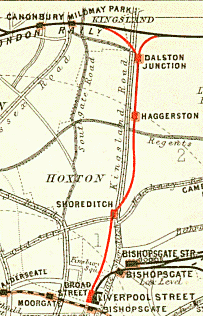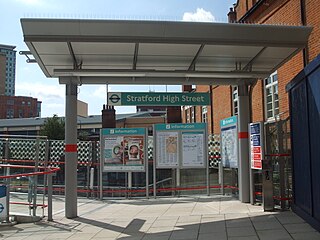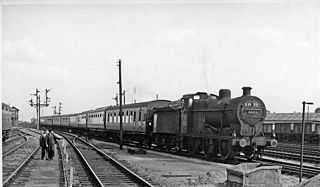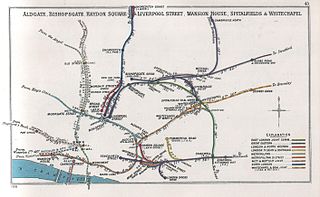
Liverpool Street station, also known as London Liverpool Street, is a central London railway terminus and connected London Underground station in the north-eastern corner of the City of London, in the ward of Bishopsgate Without. It is the terminus of the West Anglia Main Line to Cambridge, the Great Eastern Main Line to Norwich, commuter trains serving east London and destinations in the East of England, and the Stansted Express service to Stansted Airport.

Fenchurch Street railway station, also known as London Fenchurch Street, is a central London railway terminus in the southeastern corner of the City of London. It takes its name from its proximity to Fenchurch Street, a key thoroughfare in the City. The station and all trains are operated by c2c. Services run on lines built by the London and Blackwall Railway (L&BR) and the London, Tilbury and Southend Railway (LTSR) are to destinations in east London and south Essex, including Upminster, Grays, Basildon, Southend and Shoeburyness.

Shoreditch was a London Underground station located in Shoreditch in the London Borough of Tower Hamlets in east London. Originally opened by the East London Railway in 1876, the station was permanently closed in 2006 being replaced directly to the west of the site by Shoreditch High Street station in 2010.
The Eastern Counties Railway (ECR) was an English railway company incorporated in 1836 intended to link London with Ipswich via Colchester, and then extend to Norwich and Yarmouth.

The Great Eastern Railway (GER) was a pre-grouping British railway company, whose main line linked London Liverpool Street to Norwich and which had other lines through East Anglia. The company was grouped into the London and North Eastern Railway in 1923.
The Northern & Eastern Railway (N&ER) was an early British railway company, that planned to build a line from London to York. Its ambition was cut successively back, and it was only constructed from Stratford, east of London, to the towns of Bishop's Stortford and Hertford. It was always short of money, and it got access to London over the Eastern Counties Railway (ECR). It was built at the track gauge of 5 ft, but it converted to standard gauge in 1844.

Bow Road is a closed railway station in Bow, East London, that was opened in 1876 on the Bow Curve branch line by the Great Eastern Railway (GER).

Shoreditch was a railway station on the North London Railway (NLR) in Shoreditch, London, that was in use from 1865 to 1940. It was situated on a viaduct between Haggerston and Broad Street stations. It should not be confused with Shoreditch Underground station (1869–2006) on the London Underground, situated about half a mile further south. It was also not the first main line railway station to possess the Shoreditch name; Bishopsgate (1840–1875) was originally given that name.

Bethnal Green is a London Overground station on the Lea Valley lines in the southern part of Bethnal Green, in East London. The station is 1 mile 10 chains down the line from London Liverpool Street; the next station is either Hackney Downs or Cambridge Heath. It is an interchange station between three services operated by London Overground. Its three-letter station code is BET and it is in Travelcard zone 2.

Norwich railway station is the northern terminus of the Great Eastern Main Line in the East of England, serving the city of Norwich, Norfolk. It is 114 miles 77 chains (185.0 km) down the main line from London Liverpool Street, the western terminus.

Chelmsford railway station is on the Great Eastern Main Line in the East of England, serving the city of Chelmsford, Essex. It is 29 miles 60 chains (47.9 km) down the line from London Liverpool Street and is situated between Ingatestone to the west and Hatfield Peverel to the east. Its three-letter station code is CHM.

Bury St Edmunds railway station serves the town of Bury St Edmunds in Suffolk, England. The station is on the Ipswich–Ely line and all trains calling there are operated by Greater Anglia.

Stratford High Street is a Docklands Light Railway station in Stratford in London, England. It is located on the Stratford International branch of the Docklands Light Railway, which opened on 31 August 2011. The site was the location of an earlier railway station from 1847 to 1957, known initially as Stratford Bridge and later as Stratford Market - after the nearby wholesale fruit and vegetable market.

Peterborough East was a railway station in Peterborough, England. It was opened on 2 June 1845 and closed to passenger traffic on 6 June 1966. Located on East Station Road just off Town Bridge, only the engine sheds and one platform remain. The station had services running west to Northampton and Rugby, as well as to the east to March, Wisbech, and Norwich.

Bishopsgate (Low Level) was a railway station opened by the Great Eastern Railway (GER) on 4 November 1872 alongside the company's first London terminus, Bishopsgate, which stood on a viaduct (and thus became also known as Bishopsgate (High Level)). The newer station was on a lower route, leading south-west, which the GER was building to its future Liverpool Street terminus and was situated on Quaker Street, on the eastern side of Shoreditch High Street (now in the London Borough of Tower Hamlets but then in the Metropolitan Borough of Bethnal Green) near Bishopsgate.
Lower Edmonton railway station was a station in Edmonton, London opened in 1849 by the Eastern Counties Railway as part of the original Enfield Town branch line. Originally named Edmonton it was renamed as Lower Edmonton low level to distinguish it from neighbouring Lower Edmonton high level. It closed to passengers in 1939 although the line on which it stood lasted until 1964.

Globe Road & Devonshire Street was a railway station on the Great Eastern Main Line, 1 mile 54 chains (2.7 km) down the line from Liverpool Street. It was opened by the Great Eastern Railway on 1 July 1884 when the company quadrupled the double-track main line section, and it was situated close to the site of the former Devonshire Street terminus, which had closed in 1840.
The Enfield Town branch is a suburban branch line in the England. In 2014 it is in fact the combination of the original Enfield branch which was built in 1849 by the Eastern Counties Railway (ECR) and a later line built by the Great Eastern Railway (GER) from Hackney Downs to Edmonton in 1872. The line is currently a double-tracked suburban railway with services running between Liverpool Street station and Enfield Town as well as some other services running from Liverpool Street to Cheshunt. Part of the original branch is closed and little visible remains today.
The London, Tilbury and Southend Railway (LT&SR), was a British railway company, whose network connected Fenchurch Street station, in central London, with destinations in east London and Essex, including Barking, Upminster, Grays, Tilbury, Southend and Shoeburyness. The company and its assets were sold to the Midland Railway in 1912. The network over which they operated is largely intact and is currently operated as part of the Essex Thameside franchise.
Colchester engine shed was a motive power depot located in Colchester in the county of Essex in the UK. The original depot dated back to the opening of the Eastern Counties Railway (ECR) in 1843 and a second engine shed was built following the opening of the Eastern Union Railway in 1846. The ECR shed closed and the EUR shed was in use until November 1959 when the line was electrified and Colchester station rebuilt. A smaller two track engine shed was provided south of the station and after closure in the 1990s it was used for the stabling of diesel and electrical multiple units. It is currently known as Colchester Carriage Servicing Depot and units can be washed externally and cleaned internally on site.






















